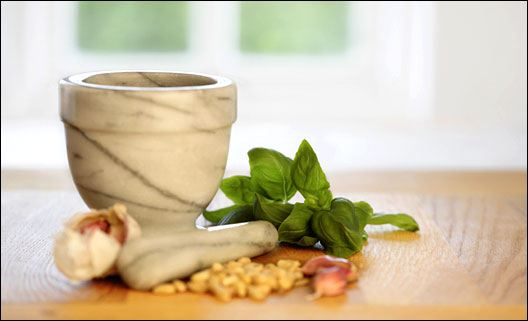
September in Iowa always brings the same delicious dilemma — what to do with all that basil.
Few herbs are as surrounded by mythology and folklore as basil. Its origins are debated, but most seem to think it came from India. There, the plant offered innumerable culinary uses: A devout Hindu has a leaf of basil placed on his breast when he dies, as a passport to paradise. Basil figures in Christian tradition as well. It was the herb Salome used to cover the smell of decay from John the Baptist’s head. Then there’s Haitian Voodoo practice, where the herb is a powerful protector; and Romanian courting rites, where a man is engaged when he accepts a sprig of basil from a woman.
All this information is of little use, though, when faced with bushels of the stuff that we pull out of our gardens the afternoon before autumn’s first expected frost. What to do when faced with more of the green leaves than you could ever consume before it loses freshness? Consider putting some up for the winter.
You can blanch and freeze the bounty with a quick dip in boiling, salted water followed by an instantaneous plunge into ice water (then drain, pat dry, and freeze in Ziplocs). But that practice only postpones the inevitable pesto, and pesto tastes best when made with fresh leaves. Making a voluptuous pesto when the leaves are fresh accomplishes the same task as blanching: It reduces the volume of the basil so it can fit in the freezer. But it also leaves you with a delicious, ready-made sauce for the cold months ahead.
Putting up abundant harvests is a great way to bring family and friends together around the rituals of food. It can take time and several hands to pick over a large amount of basil, separating the leaves from the stems. Don’t throw away those stems, by the way — they can be used to flavor an oil or vinegar, or trussed to your next roast.
Paste You Can Taste
A word about authenticity: The word “pesto” simply means “paste,” and refers not necessarily to the basil and garlic concoction we all know and love, but to the method used to make it correctly — with a mortar and pestle. (Preferably, use a marble mortar and a wooden pestle.) Why not use the food processor when making pesto? Well, a good mortar and pestle will tear the leaves gently, releasing the flavors. A food processor cuts the leaves, blocking the veins from releasing flavor. It also produces heat, which causes the aromatic oils to oxidize, altering the flavor.
One can make a pesto out of just about any combination of herbs and oils imaginable. The earliest record of something we would recognize as pesto comes from Virgil and involved parsley rather than basil. The stuff everyone thinks of when they think of pesto is Pesto alla Genovese, from the Ligurian port of Genoa. This is best made with Genoa basil (the kind with the small round leaves), extra virgin olive oil, toasted pine nuts, and a combination of Pecorino and Parmigiano Reggiano cheeses.
Make it in individual batches, then combine if you like. It’s best fresh but freezes well. Freeze it in ice cube trays, and then turn the cubes into a Ziploc and return to the freezer for convenient use later.
Classic Pesto alla Genovese
Once you have mastered this genuine recipe, feel free to experiment with other ingredients to discover interesting new flavors.
4 cups (packed) of fresh basil leaves (preferably Genoa), washed and spun dry
1 teaspoon of coarse sea salt
2 tablespoons of oven toasted pine nuts (some contest this inclusion, but I like them)
3 tablespoons of Pecorino cheese, not too strong
3 tablespoons of grated Parmigiano Reggiano cheese
1 cup of olive oil
Put the garlic, basil leaves, salt (which helps to preserve the green of the leaves), and pine nuts into the mortar.
Applying pressure, slowly mix ingredients with the pestle. Continue, adding the mixed cheeses a little at a time.
When the mixture is smooth and creamy, add olive oil to taste (to the texture you prefer) and stir to incorporate.
To dress pasta, always dilute the pesto with a little of the cooking water from the pasta.

